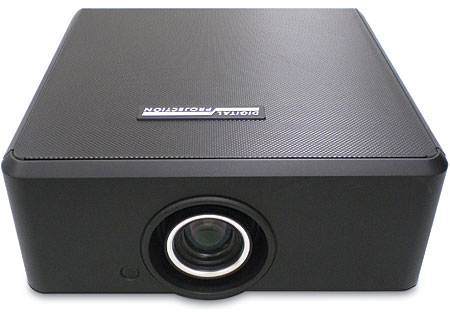Digital Projection M-Vision Cine LED DLP Projector
LED Comes on Strong

Ever since I first heard about front projectors with LED light sources, the idea has intrigued me. Before RPTVs imploded, a few LED-illuminated models were available. Now, front projectors that use this technology have begun to appear.
When Digital Projection gave me the opportunity to review its new LED-illuminated single-chip DLP projector, the M-Vision Cine LED, I jumped at the chance. I would get to play with the technology in our video testing lab, and it would be the first projector reviewed on our newly installed Stewart Filmscreen StudioTek 100 projection screen (100 inches wide, 2.35:1).
If you aren’t familiar with the StudioTek 100, it’s a unity-gain white screen that behaves as a lambertian surface. It reflects light equally in all directions. As such, it should only be used in rooms that have very dark, neutral walls, ceilings, and floors. It reveals exactly what a projector is doing without adding anything of its own to the image.
Features
Of course, the M-Vision Cine LED’s primary feature is its LED illumination. Luminus provided three PhlatLight LEDs—one red, one green, and one blue. If you use LEDs instead of a conventional lamp, there are several potential advantages. First of all, you won’t have to worry about replacing the lamp since the LEDs have a rated life span of 60,000 hours. Also, the light output and color don’t change over time. They consume much less power and generate much less heat than conventional lamps.
You can also quickly dim and brighten LEDs, so you won’t need a dynamic iris. Finally, using LEDs in a single-chip DLP projector eliminates the need for a spinning color wheel. LEDs can sequentially cycle on and off faster than color filters can move into and out of place. This greatly reduces any rainbow artifacts.
What’s the downside? Light output. The M-Vision Cine LED is rated at 600 lumens, which is far lower than most high-end projectors. As a result, this limits the image size at acceptable light output levels more than it does on comparable lamp-based projectors. Plus, any ambient light will seriously wash out the image. This was no problem at our studio; the front-projection room is fairly small and essentially a black hole, so the M-Vision Cine LED and StudioTek 100 screen were a great match for it. As you can see in the HT Labs Measures section, I got a perfectly acceptable peak-white reading.

Digital Projection lets you choose from three lens options—two zooms (1.56 to 1.86 and 1.85 to 2.40) and one fixed (0.73). Interestingly, the fixed lens adds $1,000 to the price because of its superior optics. According to Digital Projection, it simply passes on the extra cost; it doesn’t make any more profit on the fixed-lens version.
Another option is an ISCO anamorphic lens with a motorized sled, which costs an additional $13,000. You can only attach the sled to the projector in a ceiling-mount setup, and the required hardware costs another $500. I didn’t test this option, but I was told that the firmware didn’t work correctly, electronically stretching the image horizontally instead of vertically. It should be fixed by the time you read this.
The M-Vision Cine LED provides several features that are found in high-end projectors, such as color-space and color-gamut presets, color-temperature presets (labeled with actual color temperatures), and gamma presets. Even better, it has four user memories where you can store all of your settings. This turned out to be extremely useful during the review, as I’ll explain shortly. However, one feature we missed, especially in a projector in this price range, was a color management system (CMS) for dialing in a more accurate color gamut.
The projector includes two dynamic-contrast features. You can choose Dynamic Black, which varies the LED brightness, or Adaptive Contrast, which varies the DMD micromirror on/off times. Thanks to these features, it doesn’t have a dynamic iris.
- Log in or register to post comments





































































